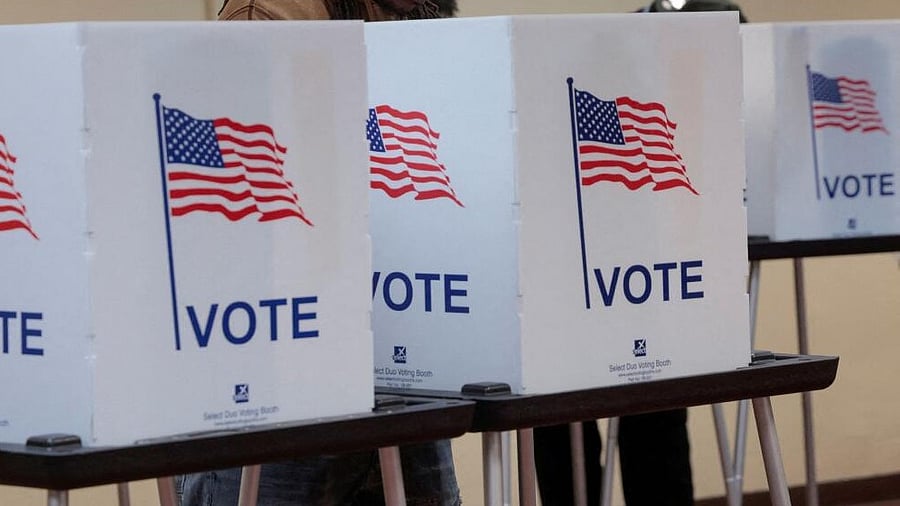
Representative image of a polling station
Credit: Reuters Photo
By Noah Feldman
Donald Trump’s latest executive order requires the Election Assistance Commission to make it harder to prove citizenship in order to register to vote. This part of the order is unlawful for two reasons: The commission is an independent agency, and the president can’t directly order it to do anything; and the National Voter Registration Act, a binding federal law, already says you can prove citizenship by checking a box saying so under penalty of perjury.
Another part of the executive order is only probably unlawful: It pressures states not to accept absentee or mail-in ballots postmarked by Election Day but received thereafter. One federal appeals court — the Fifth Circuit — has held that states can’t count such ballots; but beyond that court’s jurisdiction nearly all states count such ballots, and the president shouldn’t be able to force them to break long-standing precedent.
Other sections of the order may be lawful but are ill-conceived. One directs the Department of Homeland Security and Elon Musk’s Department of Government Efficiency to compare state voter lists with federal immigration databases to root out noncitizen voters. That’s not likely to go well, since mistakes will be made (DOGE has already made lots of them) that will interfere with legitimate voting by actual citizens. Another section instructs the Justice Department to prioritize enforcing laws against voter fraud — despite powerful evidence that noncitizens almost never register or actually vote.
Under some other presidential administration, the natural question would be, why is the White House wasting time and effort issuing an executive order that won’t be effective, given that there are other legal means to achieve some of the same objectives, such as legislation? The last two months, however, have shown us that the Trump administration simply doesn’t care if its executive orders will make a practical difference under the law. They seem satisfied to draft amateurish orders that will be successfully challenged and blocked in court.
Indeed, I’ve started to wonder if this administration intentionally puts some illegality in its orders. Doing so guarantees there will be news coverage and analysis pointing out the illegality. (You’re reading such an analysis right now.) Then, when the order is blocked in court, more coverage follows. Ditto for appeals, including those going all the way to the Supreme Court. The result is that an executive order that might otherwise go almost unnoticed has some chance of making headlines in multiple news cycles.
That being said, it’s still my job to explain the problems with this executive order, as I’ve done for many others already. I always try to get help from experts in the particular legal domain, often my colleagues at the Harvard Law School. Today I owe gratitude to Professor Nicholas Stephanopoulos, a brilliant voting rights expert, for walking me through the relevant background.
One important thing to know that I myself just learned is that the Election Assistance Commission, created by Congress in 2002, has among its jobs the responsibility to create and administer the national mail voter registration form. The form lets you register to vote in your state and includes specific instructions for each state. The very first question on the form is whether you’re a citizen.
The National Voter Registration Act specifies that the form can only require identifying information necessary to register you under the laws of a given state. Another law says that the first time you register by mail, you can do so by showing valid photo identification or a copy of a utility bill, bank statement, government check, paycheck, or other government document that shows your name and address. Citizenship is proved by checking the box.
Trump’s executive order tells the Election Assistance Commission to change this to require proof of citizenship in the form of a passport or REAL ID. The president can’t change a law specified by Congress, however. Even if he could somehow do so, he can’t simply order an independent agency to act. The Trump administration is in the midst of an unprecedented effort to undermine the independence of these agencies, to be sure. But he hasn’t yet managed to achieve the direct control he seeks.
The order directs the commission to withhold funding from states that fail to comply. If it were really illegal for states to count those ballots, then this part of the order might conceivably be lawful. And the US Court of Appeals for the Fifth Circuit blocked states from counting such ballots this past March 14. However, its holding, like those of all appeals courts, is restricted to the states under its jurisdiction, namely Mississippi, Louisiana and Texas. The president shouldn’t be able to impose it on other states by blocking receipt of money allocated by Congress.
Trump’s obsession with the myth of widespread noncitizen voting is well known. So, the executive order shouldn’t be too surprising. The only silver lining is that this order is aimed at a phenomenon that barely exists.